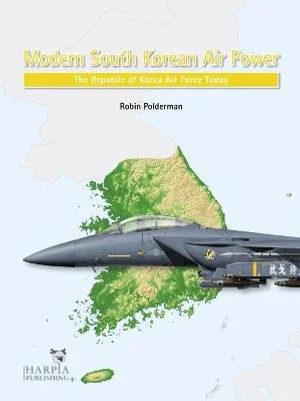
Modern South Korean Air Power. The Republic of Korea Air Force Today. By Robin Polderman. Harpia Publishing Verlags GmbH, Wien, Austria, 2021. ISBN 978-1-950394-07-4
Reviewed by David Hobbs
Robin Polderman lives in the Netherlands and has been an aviation photographer, researcher and author since 1991. His book on the Republic of Korea Air Force follows the tried and trusted Harpia formula to give readers an informative and well-balanced introduction to the subject which is well up to the publisher’s usual high standards.
It is a 256 page paperback printed in colour on high quality paper with excellent photographs of aircraft and weapons together with the unit badges worn by aircrew on their flying overalls. Data boxes show the air force command structure and list units and their bases. As one would expect there is a glossary of abbreviations, a bibliography for those who want to research more deeply into the subject and an index.
The book is divided into chapters, each of which covers a particular facet of the ROKAF to give the reader a good understanding of its background, present capability and future aspirations. The first chapter describes how it was established by Presidential Decree in 1948 and then how it has evolved to the present day force with a growing range of capabilities and aircraft types. The role of tactical aircraft to counter the threat of invasion from communist North Korea is a theme that runs through every chapter but the author explains how aircraft were transferred from the ROKAF to another American ally, South Vietnam, to help its own efforts against a communist enemy to the north. South Korea’s role in a volatile region is examined in greater depth in Chapter 8, comparing the ROKAF with the North Korean Air Force which has aircraft in larger numbers but many of them are obsolescent.
Having set the scene, Polderman describes the rather complicated ROKAF system of allocating individual aircraft serial numbers, aircraft markings and unit designations in Chapter 2 together with the force’s current order of battle. Units and their locations are listed together with a map which shows ROKAF, USAF and North Korean air bases on the peninsula. The third chapter describes the current inventory of aircraft with a ‘thumbnail’ sketch of their origins, capabilities and the numbers procured. They are all particularly well illustrated by at least one high-quality colour photograph which show the aircraft with particular clarity. Most are in flight. Thirty different fixed and rotary-wing aircraft ranging from the humble Hawker Siddeley 748 to the Lockheed Martin F-35A Lightning II joint strike fighter are included and I found the description of the Antonov/PZL-Mielic An-2 to be particularly interesting. There are believed to be at least ten in service, painted in a dark green colour scheme with duck egg blue undersides which is identical to that used by the communist Democratic People’s Republic Korea Air Force’s much larger An-2 fleet. The author discusses several roles in which South Korea’s An-2 fleet could be used and he notes that their unit takes its orders directly from the ROK Defence Intelligence Command.
The next chapter provides details of air-to-air missiles, air-to-ground missiles and bombs, targeting and reconnaissance systems and surface-to-air missiles. A number of the weapons described such as the GBU-24B Paveway III laser-guided bomb, GBU-38B JDAM and even the basic Mark 82 bomb are widely used within Western air arms and I found this chapter to be a particularly useful reference guide. It does, of course, need to be borne in mind that the aircraft and weapons that form the ‘backbone’ of the ROKAF are constantly being upgraded and while this book accurately describes the current force it will become dated in a few years time. It is to be hoped, therefore, that Harpia will update it with later editions in due course to keep it sharp and relevant. Later chapters describe the ROKAF training syllabus and the force’s modernisation plans. I was interested to read that training a single South Korean fighter pilot is estimated to cost $US4 million and could take up to eight years including four years at the Air Force Academy, two years of pilot training and three to four years sharpening skills in an operational squadron. During the summer months of their first year at the academy, cadets learn to fly para-gliders as an introduction to flight.
In summary, this an excellent introduction to the ROKAF that gives a broad but very readable description of South Korea’s air force, its roles, equipment and capabilities. Korea remains a potential flash-point in South-East Asian geopolitics and Polderman’s book is an easily-studied reference for those who wish to have a good working knowledge of forces in the region. It has equal utility in an individual collection or as part of a reference library and I thoroughly recommend it.



